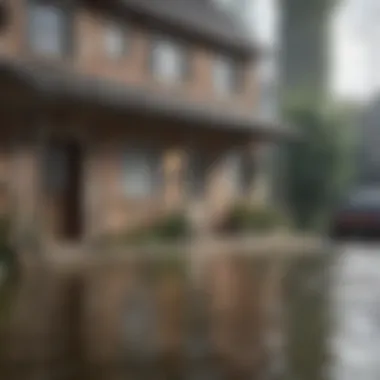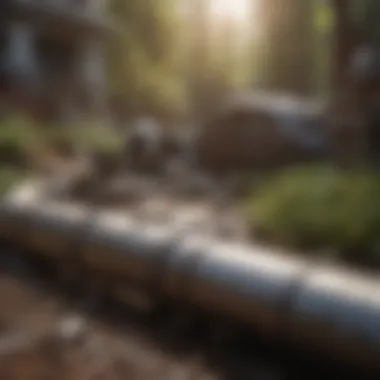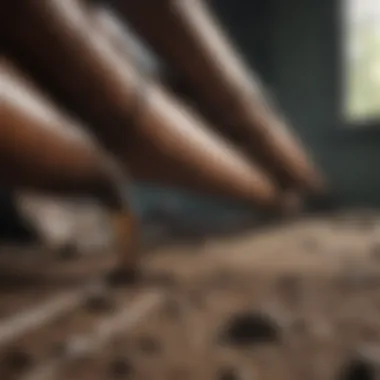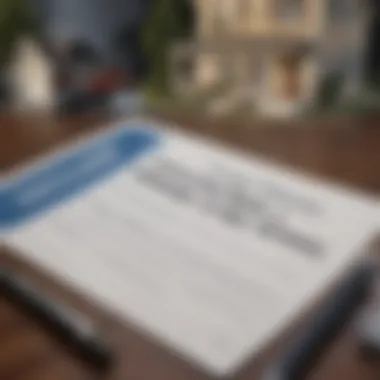Understanding Homeowners Insurance: Broken Pipes Explained


Intro
Homeowners insurance serves as a safety net for property owners, offering protection against various risks, including fire, theft, and water damage. Among these risks, broken pipes often present a challenging situation for homeowners. Water damage can lead to significant financial losses, not only due to repairs but also due to the potential for mold growth and other complications. This makes it crucial for homeowners to understand how their insurance policies address such incidents and what steps they can take to mitigate risks.
In this article, we explore the intricacies of homeowners insurance in relation to broken pipes. We will examine the different coverage options available, the complexities involved in the claims process, and practical measures homeowners can adopt to minimize the likelihood of water damage. By gaining insight into these topics, homeowners can make informed decisions about their insurance policies and maintenance practices.
Market Overview
Current Market Conditions
The homeowners insurance market has evolved significantly in recent years. Rising property values and climate change have increased the demand for comprehensive coverage. Homeowners are seeking policies that not only protect against traditional risks but also cover emerging threats such as water damage from broken pipes.
Key Economic Indicators
Several economic indicators influence the homeowners insurance market. The rate of homeownership, property values, and local economic conditions all play a role. For instance, in areas facing severe weather events, insurers may adjust policies to account for increased risk. The average premium costs can also fluctuate based on these factors, impacting the affordability of coverage for homeowners.
Major Market Trending Factors
Key trends shaping the market include:
- Technological Advancements: Insurers are leveraging technology for risk assessment and customer service.
- Increased Awareness: Homeowners are becoming more educated about their insurance needs, pushing insurers to offer tailored products.
- Regulatory Changes: New regulations can influence coverage options and pricing, affecting the overall landscape of homeowners insurance.
Understanding these market dynamics is essential for homeowners navigating the complexities of insurance coverage for plumbing issues.
By keeping these factors in mind, homeowners can make more informed decisions about their insurance policies and be better prepared for incidents involving broken pipes. The next sections will dive deeper into the coverage specifics, the claims process, and steps to take when handling such water damage situations.
Prelims
The relationship between homeowners insurance and broken pipes is a critical topic for any property owner. Understanding this connection can help homeowners navigate both potential crises and the insurance landscape more effectively. Broken pipes represent one of the more common yet overlooked issues that can arise in residential properties. The implications of such incidents can range from minor inconveniences to significant financial burdens. Hence, grasping the nuances of homeowners insurance in relation to this issue is essential.
Homeowners insurance policies vary in their coverage of water damage caused by broken pipes. Many individuals may not fully comprehend what their policy includes or excludes, which can lead to unfortunate surprises at critical moments. The potential damage to the home, financial implications, and emotional stress tied to these situations can be immense. Therefore, it is vital to understand how these incidents interact with insurance claims.
Furthermore, this article aims to provide clarity on various aspects, such as what causes broken pipes, how different types of coverage work, and the steps to take once a crisis occurs. Being informed empowers homeowners to take proactive measures, improve their risk management strategies, and ensure they are prepared for potential emotional and financial fallout from water damage events. By examining these issues, homeowners will gain insights that could prove invaluable during times of distress, thereby reinforcing the importance of understanding homeowners insurance and its interplay with broken pipes.
Notably, thorough knowledge of homeowners insurance can also drive improvements in property maintenance practices, which can mitigate the occurrence and severity of such incidents. With potential financial ramifications hanging in the balance, this topic deserves exhaustive scrutiny. Through careful analysis of the implications and solutions regarding broken pipes, homeowners can adopt a more informed approach, ensuring they protect their investment adequately.
The Importance of Homeowners Insurance
Homeowners insurance serves as a critical safety net for property owners. It offers financial protection against damage or loss of property and personal belongings. Furthermore, it can cover liabilities arising from accidents or injuries that occur on the insured property. Understanding the specific implications of homeowners insurance for incidents like broken pipes is essential for making informed decisions.
This type of insurance not only protects the physical structure of the home but also provides peace of mind. Homeowners can focus on their day-to-day lives, knowing they have coverage in place to handle unexpected events. Insurance also encourages a sense of responsibility, as policyholders are more likely to maintain their properties in order to prevent loss.
In the context of broken pipes, homeowners insurance becomes even more relevant. Water damage can lead to significant financial loss, especially if the issue is not addressed promptly. Severe damage may result in costly repairs, temporary relocation, and ruining belongings. Therefore, understanding the intricacies of homeowners insurance is crucial.
Understanding Homeowners Insurance
Homeowners insurance is a form of property insurance that covers losses and damages to an individual’s house and to assets in the home. Most policies also provide liability coverage against accidents that may occur on the property. It includes several components that work together to provide comprehensive coverage.
The coverage also typically requires an annual premium, which can fluctuate based on various factors like location, property value, and even credit score. This insurance is tailored based on the specific needs of the homeowner, ensuring adequate protection can be secured without excessive costs.
Types of Coverage


Property Coverage
Property coverage is a fundamental aspect of homeowners insurance. It protects the physical structure of the home against damages caused by defined events such as fire, theft, or vandalism. A distinctive characteristic of property coverage is its ability to cover both the home itself and any Detached structures like garages or sheds.
This type of coverage is advantageous for several reasons. It ensures that in the event of a covered incident, homeowners can receive funds to repair or replace their property without incurring crippling out-of-pocket expenses. However, a potential disadvantage is that homeowners need to be aware of the limits and exclusions of their policies, especially when it comes to water damage, which may have specific stipulations.
Liability Coverage
Liability coverage is another essential component of homeowners insurance. It protects the homeowner against claims made by visitors for injuries or damages suffered while on the property. The primary characteristic of liability coverage is that it can cover legal fees, medical expenses, and damages awarded in lawsuits.
This coverage is particularly beneficial due to the unpredictable nature of accidents. Homeowners can be held financially accountable for incidents beyond their direct control. Nonetheless, it may not cover all types of incidents, so reading the policy details thoroughly is advisable.
Additional Living Expenses
Additional living expenses (ALE) coverage comes into play when the home becomes uninhabitable due to a covered loss. It covers costs entailed in living elsewhere while repairs are made. The key feature of ALE coverage is its ability to alleviate the financial burden of temporary lodging, food, and other necessary expenses.
For many homeowners, having this coverage is invaluable in a crisis. However, it often comes with limits and specific time frames for how long the coverage applies. Homeowners should be careful to understand these parameters to ensure they have adequate support during repairs.
What Causes Broken Pipes?
Understanding what causes broken pipes is essential for homeowners. This knowledge can help prevent costly damages and guide them in making informed decisions regarding their insurance coverage. Broken pipes can lead to significant water damage and costly repairs, impacting a homeowner's finances and insurance claims. Knowing the common causes allows homeowners to take proactive steps in maintaining their plumbing systems. Additionally, understanding the environmental factors that can exacerbate these issues is vital.
Common Causes Explained
Several factors contribute to pipe breakage. One primary cause is poor installation. When plumbing systems are not installed correctly, it can lead to weak spots in the pipes that are more prone to breakage. Over time, even small installation errors can have serious consequences.
Another significant factor is the aging of pipes. Older pipes, particularly those made of materials like galvanized steel or cast iron, can deteriorate significantly. They may develop rust, corrosion, or cracks, leading to eventual breakdown. Homeowners should be vigilant about the condition of older plumbing.
Additionally, sudden changes in water pressure can stress pipes. High pressure can cause pipes to burst, while low pressure may lead to leaks. Homeowners need to monitor their water pressure for safety.
Key Causes of Broken Pipes:
- Poor installation
- Aging materials
- Sudden shifts in water pressure
- Freezing temperatures
- Corrosion and rust
Seasonal Factors
Seasonal changes can exert stress on your plumbing system, leading to broken pipes. Cold winters can freeze water inside pipes, leading to expansion and, ultimately, cracks. During thaws, the resulting pressure changes can exacerbate existing vulnerabilities in the piping system.
In addition, heavy rains in spring or summer can lead to flooding, increasing soil pressure around the foundation of a home. This can also impact the pipes within the ground, leading to breaks or leaks. Homeowners should remain aware of how seasonal changes affect their plumbing.
Important Seasonal Considerations:
- Winter freeze and thaw cycles
- Heavy spring or summer rains
- Monitoring underground pipe pressure
Homeowners should regard these factors seriously. By taking preventative measures against these common causes and understanding seasonal impacts, the risk of broken pipes can be greatly reduced.
Homeowners Insurance and Broken Pipe Coverage
Homeowners insurance plays a critical role when dealing with water damage resulting from broken pipes. This segment of the article seeks to clarify the essential attributes of homeowners insurance, particularly in relation to coverage for pipe-related incidents. Understanding how your insurance policy addresses such scenarios is vital for homeowners who want to protect their investments and avoid financial pitfalls.
The implications of homeowners insurance for broken pipes encompass a variety of aspects: standard coverage provisions, common exclusions, and specific limitations that may affect a homeowner's claim. Insurance provides peace of mind, knowing that you are safeguarded against unforeseen damages, but it is crucial to grasp the specific terms of your policy. Being informed helps in making strategic decisions during emergencies.


Standard Coverage for Water Damage
In most homeowners insurance policies, standard coverage for water damage includes incidents caused by broken pipes. Such coverage typically extends to the costs necessary for repairs, restoration, and any resulting damages to personal property.
To break it down further, here are key elements often included in standard coverage:
- Repair Costs: Insurers generally cover the expenses associated with fixing or replacing the damaged plumbing.
- Property Damage: If personal belongings, structures, or fixtures are harmed, coverage may assist with repair or replacement costs.
- Alternative Living Expenses: If a broken pipe makes the home uninhabitable, many policies offer financial support for temporary accommodations.
The importance of knowing these aspects cannot be overstated. If you ever face the unfortunate event of a pipe break, a clear understanding of your coverage can facilitate a smoother claims process.
Exclusions and Limitations
While homeowners insurance can provide extensive coverage for water damage, it's equally important to be aware of the common exclusions and limitations. Exclusions can significantly affect the outcome of a claim. For instance, most policies do not cover damages caused by poor maintenance or neglect. This means if a broken pipe results from a lack of proper upkeep, your claim may be denied.
Some typical exclusions include:
- Gradual Damage: Insurers often exclude damages caused by slow leaks.
- Flood Damage: Standard policies usually do not include flood damage, necessitating separate flood insurance.
- Unattended Property: If the homeowner leaves the property unattended without taking preventive measures, the claim might face rejection.
Moreover, knowing the limitations set forth in your policy will help you avoid surprises when filing a claim. For example, many policies may set a maximum payout limit for water damage claims, and being unaware of this can hinder recovery efforts significantly.
Navigating the Claims Process
Understanding the claims process is vital for any homeowner facing pipe-related issues. This section explores the necessary steps one must take after a broken pipe incident. It addresses the importance of quick action, proper documentation, and effective claims submission. Knowing these elements can greatly influence the outcome and efficiency of the claims process.
Steps to Take Immediately After a Break
When a pipe breaks, swift action can help minimize damage and facilitate a smoother claims process. The following steps should be prioritized:
- Shut off the Water Supply: The first action is to locate and turn off the main water valve. This will stop further water flow and reduce damage to your property.
- Assess the Situation: After controlling the water supply, evaluate the extent of the damage. Take visible note of affected areas to have a clear understanding of the damage’s scale.
- Contact Professionals: If the damage is extensive, consider contacting a plumber immediately. They can provide essential services and insights on what actions to take next.
- Take Photos: Document the scene by taking clear pictures of the broken pipe and any resultant damage. Visual evidence is crucial for your claim.
Documenting the Damage
Proper documentation is indispensable when filing a claim. Insurers require detailed records to assess the claim effectively. Focus on the following:
- Photographic Evidence: Capture multiple angles of affected areas and include close-ups of any broken pipes.
- Inventory of Damaged Property: List all items that sustained damage, including furniture, flooring, appliances, and any structural impacts.
- Professional Estimates: If possible, obtain written estimates or reports from professional plumbers or restoration services. These documents can support your claim with professional opinions regarding the damage and necessary repairs.
- Keep Receipts: Maintain receipts from any emergency repairs, cleaning services, or temporary accommodations needed due to the damage. This information can bolster your claim and expedite the process.
Submitting a Claim
Once documentation is complete, the next step is submitting the claim to your insurance provider. Here’s a structured approach:
- Review Your Policy: Before engaging with your insurance company, review your homeowners insurance policy. Understand your coverage limits and any exclusions regarding water damage.
- Contact Your Insurer: Reach out to your insurance company promptly. Use the claims hotline or your agent’s contact for an efficient process.
- Provide Detailed Information: During the claims submission, provide all documented evidence. Include photos, inventory of damages, and any professional estimates you secured.
- Follow Up Consistently: After submission, stay in contact with your insurer. Regular follow-ups will help you stay informed about the status and facilitate any additional information requests.
Thorough documentation and prompt action can significantly enhance the likelihood of a favorable claims outcome.
This navigation through the claims process is essential for safeguarding your interests as a homeowner dealing with the unexpected event of broken pipes. By taking immediate action, documenting damages meticulously, and submitting a comprehensive claim, you position yourself for a smoother recovery from the incident.
Common Pitfalls in Claims Related to Broken Pipes
Broken pipes can lead to significant damage in a home, and navigating the claims process can be equally challenging. Homeowners insurance is supposed to provide relief in such instances, but certain pitfalls can hinder the success of claims. Understanding these common pitfalls is crucial for homeowners, as avoiding them can ensure a smoother claims process. This section will specifically address two major pitfalls: underreporting the damage and misunderstanding policy terms. Both can lead to insurmountable issues when trying to recoup losses, leaving homeowners frustrated and financially vulnerable.
Underreporting the Damage


One of the most frequent issues seen in claims related to broken pipes is underreporting the damage. Many homeowners may not fully comprehend the extent of the damage caused by water. If a homeowner only reports visible damage, they may miss significant issues like mold growth or structural weakening caused by unseen water exposure.
Key Considerations:
- Complete Assessment: It is important to conduct a thorough inspection of the affected area and its surroundings. Failing to do so can lead to insufficient claims.
- Professional Help: Hiring a water damage restoration expert can provide a clear picture of the damage, ensuring all affected areas are duly reported.
- Timeliness: Delaying the assessment can worsen the situation, making it crucial to act promptly after discovering a broken pipe.
Proper documentation during this phase is critical. Take photographs and keep records of any repairs for submission with the claim. Underreporting may save time initially, but it could result in more extensive and costly repairs later, leading to greater financial loss in the long term.
Misunderstanding Policy Terms
Another significant issue homeowners face is misunderstanding their policy terms. Insurance policies can be complex, filled with legal jargon that may be hard to decipher. This misunderstanding often results in homeowners believing certain incidents are covered when they are not.
Key Points to Address:
- Read the Fine Print: Homeowners should take the time to carefully read through their insurance documents. Knowing what is covered, including exclusions, is vital for informed decision-making.
- Ask Questions: If something is unclear, contacting the insurer for clarification can prevent assumptions that may lead to rejection of a claim.
- Coverage Limits: Policies often have specific limits on water damage claims. Understanding these can help set realistic expectations regarding reimbursement.
When it comes to your insurance policy, knowledge is power. Homeowners who are well-versed in their coverage can navigate the claims process with greater confidence and assurance.
Failing to grasp these key terms can result in denied claims or insufficient compensation, ultimately undermining the purpose of having insurance. Homeowners must engage actively with their policies to avoid these common pitfalls, ensuring they are adequately protected against the unpredictable nature of incidents involving broken pipes.
Preventative Measures for Homeowners
Taking preventative measures is crucial for homeowners to minimize the likelihood of encountering broken pipes and related damages. This section discusses effective strategies to protect one’s property, highlighting specific actions that can result in significant savings on future repair costs and peace of mind.
Regular Maintenance Checks
Regular maintenance checks are essential for identifying potential issues before they escalate. Homeowners should conduct routine inspections of their plumbing systems. Look for leaks, corrosion, and signs of wear. Areas that often require attention include:
- Pipes: Inspect for signs of rust or deterioration.
- Fittings: Ensure that joints are secure and not showing any wear.
- Appliances: Check washers and dishwashers for leaks.
Implementing a schedule for these checks can help in catching problems early. Establishing a relationship with a qualified plumber can also provide access to expert advice on maintenance practices. By proactively managing plumbing systems, homeowners can avoid costly repairs and significant water damage.
Winterizing Your Pipes
Winterizing pipes is particularly important in regions prone to freezing temperatures. A freeze can cause water to expand in the pipes, leading to cracks or bursts. Homeowners should consider the following steps:
- Insulating Pipes: Use foam insulation or heat tape for vulnerable areas.
- Draining Water Systems: Empty outdoor hoses and sprinkler systems to prevent freezing.
- Keeping Garage Doors Closed: Protect plumbing that runs through unheated spaces.
Taking these steps before cold weather hits can save homeowners from the headache and expense of repairs come spring.
Choosing Quality Materials
Investing in quality plumbing materials has long-term benefits. Using high-quality pipes and fittings can enhance durability and reduce the risk of failures. Here are a few considerations:
- Material Selection: For instance, PEX or copper pipes are more resistant to pressure changes compared to PVC.
- Reputable Brands: It is wise to choose products from well-established manufacturers that have a history of reliability.
By prioritizing quality over cost, homeowners can significantly lower the chances of experiencing pipe issues. Thus, it's a sound financial decision that pays off in the long run.
Planning ahead and implementing these preventative measures not only protects your home but also reduces stress related to unexpected damages.
Finale
In the context of homeowners insurance, understanding the implications of broken pipes is crucial. This knowledge not only informs policy selection but also guides individuals in taking necessary preventative measures. Homeowners must recognize that while insurance is a safety net, it does not eliminate the need for proactive maintenance.
Several key elements come to light when reviewing the intersection of homeowners insurance and broken pipes:
- Coverage Clarity: Homeowners must comprehend what specific types of water damage their policies cover. This includes distinguishing between standard coverage for sudden pipe failures and exclusions that may apply in cases of neglect.
- Navigating Claims: The claims process can be complex and daunting. Homeowners need to be vigilant about documenting damages and adhering to their insurer's requirements. Lack of understanding can lead to denied claims, which can prove costly in the event of water damage.
- Preventative Action: Taking steps to prevent broken pipes is more cost-effective than dealing with the aftermath. Regular maintenance checks and winterizing pipes are essential strategies.
Understanding these aspects significantly benefits homeowners. It empowers them to make informed decisions about their insurance policies and reinforces the importance of regular property maintenance. With a comprehensive approach, homeowners can mitigate risks associated with broken pipes and avoid pitfalls in the claims process.







